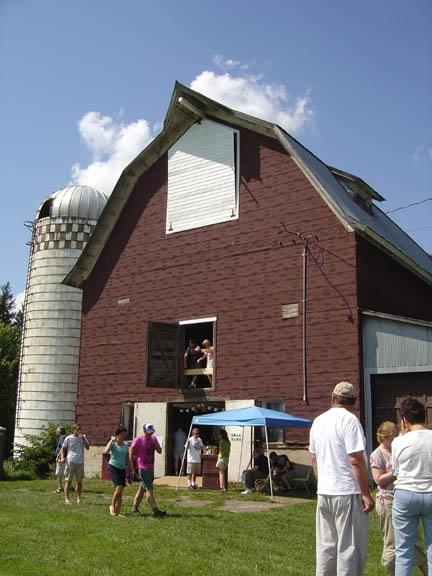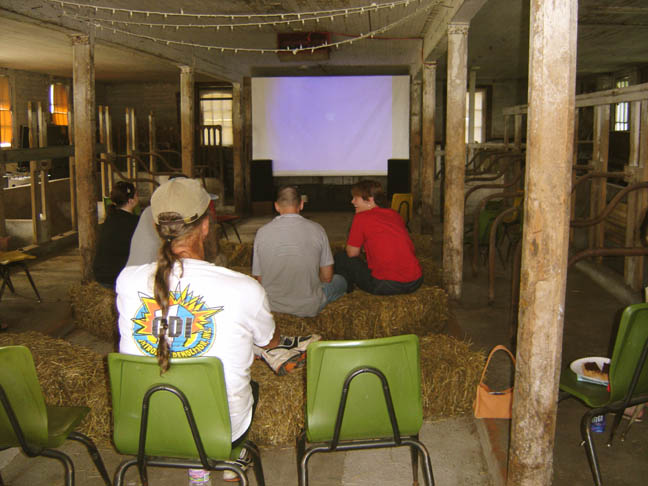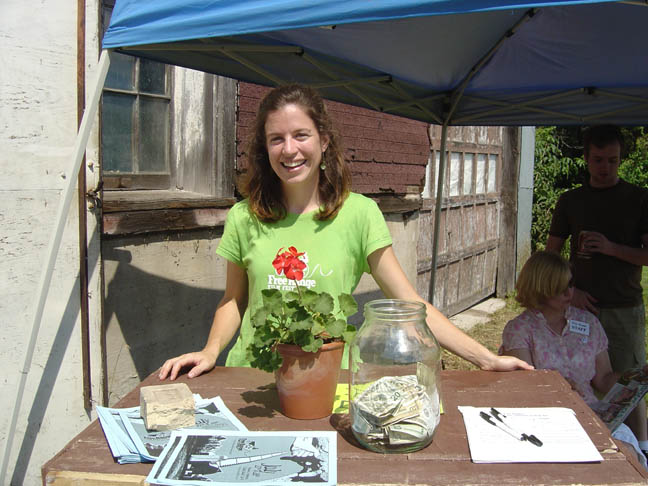Film at Home on the Range
Hannah Dentinger indulged in the Fourth Annual Free Range Film Festival in the waning days of last month. It goes down annually in Wrenshall, MN, near Duluth. As my grandmother would have said, it was gemischte pickles, but worth it, all in all.



July 28 was a sticky-hot day to spend in a barn watching short films. But it was worth it. I arrived at the end of a film and elected to tour the three screening rooms while it wrapped up. The barn doors led directly into one of the screening rooms, where moviegoers sat on chairs and—a nice touch—on bales of hay, flanked on one side by stalls long vacated by their bovine residents. On the other, a concessions stand offered cold pop, candy bars and popcorn.
Upstairs, the ceiling of the barn arced high above in the gloom. This was the biggest screening room, equipped with rows of plastic chairs. Near the entrance, cold water was provided in a small room decorated with fairy lights for visibility. We chose seats in the main screening room under the vaulted ceiling, which, just visible high above in the darkness, gave one the sensation of sitting in an unusually cozy underground cavern. We munched on popcorn and Rice Crispy bars sold by some 4-H campers at an outdoor stand that also offered hot dogs, sloppy joes, and lemonade.
The first film I saw in full was Startle Pattern, directed by Eric Patrick. In this stop-motion animated short, a pale clay figure tosses and turns in bed. He is disturbed by dreams—one in which the floor of his bedroom becomes the surface of deep water, and another in which a wall crumbles, revealing a secret passage to a red velvet-upholstered theater where a film of a female sleeper is shown. Although there was no discernible storyline, the film was eerie and atmospheric. The same applies to an entry shown later that afternoon, a Greek film called Single Bed, also consisting partly of stop-motion animation. In the short, directed by George Kouvaras, a coffee-swilling filmmaker appears to be attacked and/or replaced by her own clay figurine. Like Startle Pattern, Single Bed has a vaguely sinister atmosphere and a tendency towards narrative disintegration.
C. Beck, a documentary by Deb Wallwork and Mike Hazard, is a mere eight minutes long, but it conveys a great deal about its subject. Charles Beck is an artist who lives in Fergus Falls and creates woodblock prints of a spare, unshowy beauty. (See Wallwork’s interview with Beck on mnartists.org.) In the film, we accompany Beck on drives around the countryside that inspires him. We see him at work, methodically gouging patterns in wood blocks and shaving long curls of wood from chunks of wood that become sleek, stylized ducks. To create a new, unexpected color he mixes the last, crusty remnants of paints, explaining that he hates waste of any kind. Beck is 83 years old, but continues his work with a quiet intensity.
Everybody Promenade (directed by LeAnn Erickson) was possibly the most promising documentary film from the description in the program—“The Men of Sac City, Iowa live to dance! On tractors!” But the film itself was disappointing. The Nemaha Tractor Promenade is an annual square dance where a number of local farmers—half of them in drag—execute the traditional steps on old-fashioned Farmall tractors. Though the subject seemed tailor-made for a warm, funny short documentary, its treatment was inappropriately serious-minded. The quality of the sound recording, additionally, was so poor that the interviewees could hardly be understood. The filmmakers lavished time on the origin of Farmall tractors and the farmers’ family histories—which might have been interesting could they be heard properly—making the 27-minute short film feel a great deal longer. The climactic tractor dance itself was shot from above with a stationary camera trained on the center of the intersection of two city streets where it is performed, with the result that when everybody did promenade, they were nearly all out of range of the camera, and the audience ended up staring at asphalt.
Three of the films were Duluth-centered. First, the experimental five-minute film called 12 Moons on Gichi Gami was put together by Mark Ryan from shots taken by a webcam on Duluth’s aerial lift bridge. It was interesting to watch fog, ice and snow creep forward and retreat with the changing seasons, and to watch ships passing under the bridge from this unusual angle. According to Ryan, who spoke briefly at the festival, his timing was lucky, because shortly after he created his film, the webcam was replaced with a different, inferior model. Hatchet is a music video of the track from the internationally known Duluth band Low’s newest album. It was directed by Scott Bateman, and can be viewed on Low’s website . The funky, funny cartoon images caused a great deal of mirth among the audience and the song, appealing even to non-Low-enthusiasts, had many a toe tapping.
A short “campaign ad” from Mr. Nice for Mayor was then inserted into the program. Mr. Nice is a blue felt hand puppet (with a MySpace page where you can view the ad) that is attempting to run for the office of mayor of Duluth, although I understand that puppets are not allowed on the ballot. It seems that this is a write-in campaign. Jim Richardson of Gonzo Science (a column once featured in the defunct Duluth weekly The Ripsaw and now appearing in Transistor) introduced the clip, which I took to be a tongue-in-cheek commentary on Duluth politics that went a bit over my head.
The final film of the afternoon session, and the best, was a polished 30-minute documentary from Eric Flagg entitled Gimme Green. Lawns, we are informed, are America’s largest irrigated crop—a sobering fact in view of the increasingly serious droughts affecting various parts of the country. Flagg follows sod farmers over enormous stretches of uniform turf. He presents interviews with homeowners who spend thousands of dollars—and years of their lives—perfecting their front yards. He even includes a successful purveyor of synthetic “grass” in the increasingly populous and parched Southwest. The absurdity of our fascination with manicured lawns is amply demonstrated with no need for directorial commentary. The interviewees speak for themselves, and Flagg’s hands-off direction gives damning range to their self-parodic pride in the state of their grass. The staggering amount of water, fossil fuels, and poisons used to maintain these lawns speaks to a moral bankruptcy at the heart of (sub)urban America. Yet the director’s light touch kept the audience engaged and amused. Gimme Green is a delightful example of what can be accomplished in half an hour by an intelligent and observant filmmaker.
My first experience of this event has me convinced of the value of promoting independent filmmaking in Minnesota, and it is with great anticipation that I await the Fifth Annual Free Range Film Festival. The setting—a huge classic barn on a quiet country road south of Wrenshall, Minnesota—is charming. The volunteer staff are welcoming. The popcorn is organic—and so is the festival itself, a grassroots effort which has become a fixture of northern Minnesota’s summer entertainment offerings.